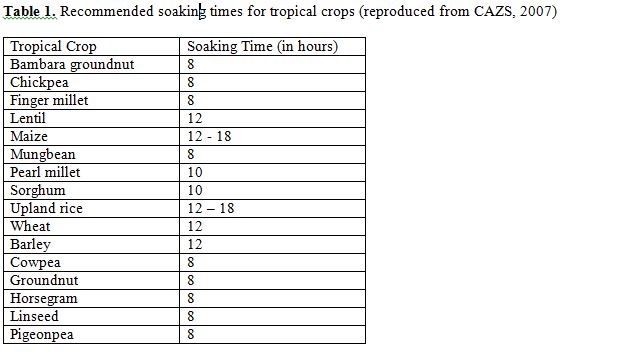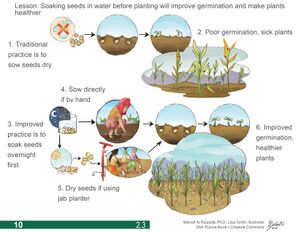Chapter 1.3
1.3 - Soaking seeds before planting (seed priming)
Samantha Martin, University of Guelph, Canada
Suggested citation for this chapter.
Martin,S. (2022) Soaking seeds before planting (seed priming). In Farmpedia, The Encyclopedia for Small Scale Farmers. Editor, M.N. Raizada, University of Guelph, Canada. http://www.farmpedia.org
Introduction
There are many problems that subsistence farmers face all over the world. One major problem that affects both yield and income equally is low germination rates for several important crops. “In the semi-arid tropics, … unpredictable and erratic rainfall, poor soils, [and] low quality seeds” contribute to low germination rates; so as a result, many farmers are forced to plant 2-3 seeds per hole while only expecting one of these seeds to properly establish itself in the soil (DFID, 2000). Poor crop establishment also occurs because these seedlings are unable to outcompete weeds for nutrients in the soil as well as for water and sunlight. The transition from seed to seedling is a very fragile one. If a seed is to grow properly, seeds must germinate and emerge, both fast and consistently in the field so that the seedlings can maximize the growing benefits from water, light and nutrients from the soil (CAZS, 2007). A very simple intervention that farmers can use to improve germination as well as strengthen their seedlings is to soak their seeds in water before planting them. This chapter will describe seed soaking and its benefits, provide a breakdown of methods including correct usage, discuss the issues with seed soaking, as well as provide alternatives to using water to soak seeds.
Description of seed soaking
Seed soaking is a very simple intervention to both understand and to put into practice. This practice includes soaking seeds in water for a prescribed amount of time, drying them, and then planting. “Seeds that are pre-hydrated and then surface-dried have a better chance of absorbing water from the soil because they germinate more quickly and the roots they produce grow faster, seeking moisture deep in the ground” (DFID, 2007). Once seeds are soaked and dried, they can either be immediately sown into a field, or they can be kept in storage for several days if weather conditions delay planting (DFID, 2007).
Benefits to seed soaking
There are many benefits to soaking seeds before planting. First, soaking seeds mainly increases germination rates among many different crops. Studies and farmers have reported, “that primed crops emerge faster, grow more vigorously, and in some cases use less fertilizer” (DFID, 2000). These effects allow seedlings to outcompete weeds for water, light and nutrients from the soil, which in turn suppresses weeds and makes crops less susceptible to disease (CAZS, 2007; Anwar et al., 2012). Next, because uniform germination is much higher when seeds are soaked, farmers can increase their overall yield because, rather than planting 2-3 seeds per hole, they can plant 1 seed per hole, thus giving farmers more seeds to plant, and more yield (reported yield increases have ranged from 20% to >200%) (CAZS, 2007). After soaking chickpea seeds for 16 hours and then drying them to approximately 30% moisture content, there was a reported 40% yield improvement than when seeds were not primed (Ghassemi-Golezani, 2008). Furthermore, soaked seeds are reported to emerge faster (approximately 1-3 days sooner), flower and mature earlier (up to 10 days sooner), which means that if there is a second crop being planted, it can also be planted sooner (CAZS, 2007; Ibrahim, et al., 2013). In a study conducted regarding soaking wheat seeds, seeds that were not soaked reached 50% emergence in approximately 5.5 days, whereas seeds that were soaked for 8 hours reached the same stage at approximately 3.5 days (Murungu, 2011). Upland rice also had similar results – when seeds were not soaked there was a 59% germination rate of seeds planted. However, when seeds were soaked for 12 hours and dried for 2 hours, there was a 78% germination rate among planted seeds (Ibrahim, et al., 2013). Moreover, this practice allows farmers to sort their seeds at the same time and remove those seeds that float to the top because they are deficient or diseased from those that sink to the bottom and should be planted (IRRI, 2016). Finally, there is essentially no cost and low-risk associated with seed soaking, so “it should be very attractive for farmers to prime their seed as a form of insurance” (Rajbhandari et al., 2014).
How to: Seed soaking
Submerge seeds to be planted in a bucket of water. Once placed in water, remove the seeds that float to the top as they are diseased or defective and will not grow properly if planted. Consult a ‘safe-limit’ table to determine the proper amount of time to soak seeds. Do not soak for less or more time than is recommended. Dry seeds after the soaking period, either by laying them in the sun or by using a cloth. Sow seeds immediately, or store them in a dry location if sowing is delayed (IRRI, 2016).
Correct usage
The most important aspect of seed soaking has to do with the amount of time that the seeds are soaked for. In order for seed soaking to have a positive effect on germination, the seeds cannot be under or over soaked. If seeds are under soaked, they will not realize all the benefits of seed soaking and if seeds are over soaked, they have the potential to germinate before being planted. This causes new problems for subsistence farmers because they are no longer sowing seeds, but rather transplanting seedlings. The Centre for Arid Zone Studies at Bangor University researched the prime soaking time for many different tropical crops. Table 1 shows these recommended soaking times.
The majority of crops require 8 hours of soaking before it will make a viable difference to their germination and growth. For most farmers, this would entail soaking the seeds overnight and then using the next day to dry them.
Critical analysis
There are some issues that are associated with soaking seeds before planting. First, while it may not cost farmers much in terms of money, it does take time to soak the seeds and dry them. Many farmers are eager to plant when they anticipate the beginning of the rainy season, and are thus unwilling to wait the prescribed soaking and drying period for each crop. However, when seeds are initially planted, they spend a large amount of time simply absorbing water, so soaking seeds actually jumpstarts the planting process (DFID, 2000). As well, this does take extra labour to soak and dry seeds before planting them. However, it is important that seeds are dried properly, especially if farmers are using any form of sowing machinery, such as a jab planter. If seeds are wet, they will clump together and not plant properly. Many farmers are hesitant to put this practice into their collection of farming customs, especially because they find it difficult to believe that something so simple can have such an important and substantial difference (DFID, 2000). Despite that, much of the research has shown that by encouraging farmers to soak some of their seeds for the prescribed amount of time and plant them beside their seeds that were not soaked, these farmers were able to experiment and share the practice with other farmers in their area (DFID, 2000). There is a need for education for subsistence farmers so that they understand the great benefits that can be realized by such a simple and low-risk practice.
Alternatives to water
While soaking seeds in water alone provides many benefits to farmers, there are alternatives to water that could be used to supplement plant growth, especially in areas with sandy or nutrient deficient soils. Some important nutrients that have been identified that can be added to the water while soaking includes, in the case of legume seeds, phosphorous, molybdenum, zinc, and bacteria like rhizobia (DFID, 2007). This intervention “gives farmers better control because micronutrients [molybdenum and zinc] are difficult to apply evenly to the soil, [and] it also makes the amounts needed much smaller [because] they are absorbed directly by the primed seed” (DFID, 2007, p. 5). Adding nutrients directly to the water means that farmers can spend less money on fertilizers as well as spend less time spreading these fertilizers. This also means that these nutrients are applied evenly to all seeds and that their capacity to support plant growth is fully maximized.
Picture Based Lesson to Train Farmers
For the South Asian version (pictures only, text for you to insert), click this link for lesson 2.3:http://www.sakbooks.com/uploads/8/1/5/7/81574912/2.3.pdf
For the East/South Asian version (pictures only, text for you to insert), click this link for lesson 2.3:http://www.sakbooks.com/uploads/8/1/5/7/81574912/2.3e.s.a.pdf
For the Sub-Saharan Africa/Caribbean version (pictures only, text for you to insert), click this link for lesson 2.3:http://www.sakbooks.com/uploads/8/1/5/7/81574912/2.3subsaharan_africa_carribean.pdf
For the Latin-America version (pictures only, text for you to insert), click this link for lesson 2.3:http://www.sakbooks.com/uploads/8/1/5/7/81574912/2.3latin_america.pdf
For North Africa And Middle East version (pictures only, text for you to insert), click this link for lesson 2.3:http://www.sakbooks.com/uploads/8/1/5/7/81574912/2.3n._africa_middleeast.pdf
Source: MN Raizada and LJ Smith (2016) A Picture Book of Best Practices for Subsistence Farmers. eBook, University of Guelph Sustainable Agriculture Kit (SAK) Project, June 2016, Guelph, Canada.
How to get started: Useful links
Seed Priming – The GAIA Movement
A sure bet: seed priming and participation – DFID: https://assets.publishing.service.gov.uk/media/57a08bf5ed915d3cfd00108a/RIU_pocketguide_9.pdf
On-Farm Seed Priming: Soaking Times – CAZS Natural Resources
How to treat seeds (Rice seeds) – International Rice Research Institute: http://www.knowledgebank.irri.org/index.php#seed-dormancy
Priming gets rice off to a good start in upland Africa and Asia: https://assets.publishing.service.gov.uk/media/57a08be340f0b64974000e4a/PSP25.pdf
Seed priming makes good stands of maize the rule rather than the exception: https://assets.publishing.service.gov.uk/media/57a08bdded915d622c000f59/PSP28.pdf
A low-cost boost for crops in poor soils: https://assets.publishing.service.gov.uk/media/57a08bdee5274a31e0000e1e/PSP30.pdf
Seed priming in wheat, barley, sorghum, pearl and finger millet in South Asia and Africa: https://assets.publishing.service.gov.uk/media/57a08be3e5274a27b2000e2b/PSP27.pdf
References
1. Anwar, M. P., Juraimi, A. S., Puteh, A., Selamat, A., Rahman, M. M., & Samedani, B. (2012). Seed priming influences weed competitiveness and productivity of aerobic rice. Acta Agriculturae Scandinavica, Section B - Soil & Plant Science, 62(6), 499–509. https://doi.org/10.1080/09064710.2012.662244
2.CASZ, Centre for Arid Zone Studies. (2007). On-Farm Seed Priming: Soaking times. Retrieved from
3.DFID, Department for International Development. (2000). An Old Technique - A Bucket of Water - Increases Crop Yields. Retrieved from https://assets.publishing.service.gov.uk/media/57a08d87e5274a31e00018f8/RLPSRReview8.pdf
4.DFID, Department for International Development. (2007). A sure bet: seed priming and participation. Retrieved from https://assets.publishing.service.gov.uk/media/57a08bf5ed915d3cfd00108a/RIU_pocketguide_9.pdf
5.Ghassemi-Golezani, K., Sheikhzadeh-Mosaddegh, P., & Valizadeh, M. (2008). Effects of Hydropriming Duration and Limited Irrigation on Field Performance of Chickpea. Research Journal of Seed Sciences, 1(1), 34–40. https://doi.org/10.3923/rjss.2008.34.40
6.Ibrahim, N. D., Bhadmus, Z., & Singh, A. (2013). Hydro-Priming and Re-Drying Effects on Germination, Emergence and Growth of Upland Rice [Oryza sativa L.]. Nigerian Journal of Basic and Applied Sciences, 21(2), 157–164. Retrieved from http://search.ebscohost.com/login.aspx?direct=true&AuthType=cookie,ip,shib&db=awn&AN=njbas-91698&site=ehost-live\nhttp://www.ajol.info/index.php/njbas/article/view/91698
7.IRRI, International Rice Research Institute. (2016). How to treat seeds. Retrieved from http://www.knowledgebank.irri.org/index.php#seed-dormancy
8.Murungu, F. S. (2011). Effects of seed priming and water potential on seed germination and emergence of wheat (Triticum aestivum L.) varieties in laboratory assays and in the field. African Journal of Biotechnology, 10(21), 4365–4371. https://doi.org/10.5897/AJB10.1630
9.Rajbhandari, N. P., Ransom, J. K., Adhikari, K., & Palmer, A. F. E. (2014). Sustainable maize production systems for Nepal. Kathmandu


